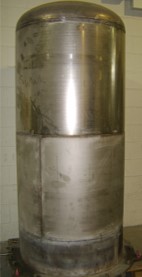Share this
What is Debinding?
by Therser UK on 09-May-2023 09:37:34
Debinding, also known as solvent extraction or removal of binders, is a process used in powder metallurgy and other manufacturing techniques involving the use of binders or additives. It involves the removal of organic materials, such as binders, lubricants, or additives, from a green part or compacted material to obtain a porous or fully dense final product.

The debinding process is typically employed in the production of metal and ceramic components through techniques like metal injection molding (MIM), ceramic injection molding (CIM), and powder compacting. In these processes, a mixture of fine metal or ceramic powders is combined with a binder material to form a feedstock. The binder helps bind the powders together and provide the necessary green strength for subsequent handling and shaping.
Once the component is formed, it undergoes debinding to remove the binder from the part. The debinding process is crucial as it prepares the green part for further processing, such as sintering or densification. The removal of the binder allows for the consolidation of the powders and the elimination of voids, resulting in a denser and stronger final product.
Debinding can be achieved through various methods, including thermal debinding and solvent debinding:
-
Thermal debinding: In this method, the green part is subjected to elevated temperatures in a controlled atmosphere, typically in a furnace. The binder material undergoes thermal decomposition and vaporization, leaving behind a porous structure. The temperature and time of thermal debinding are carefully controlled to avoid thermal shock or distortion of the part.
-
Solvent debinding: Solvent debinding involves immersing the green part in a suitable solvent that selectively dissolves the binder material. The solvent penetrates the part and dissolves the binder, forming a binder-solvent solution. The part is then dried to remove the solvent, leaving behind a porous structure. Solvent debinding is often used for parts with complex geometries or delicate features that may be susceptible to distortion during thermal debinding.
After the debinding process, the resulting part is commonly referred to as a brown part or a debound part. This debound part can then undergo further processing, such as sintering or densification, to achieve the final desired properties, including strength, density, and dimensional accuracy.
The specific debinding method and parameters depend on the materials, binder systems, part complexity, and desired final properties. It is important to carefully optimize the debinding process to ensure the removal of the binder without compromising the integrity or shape of the part.
Please contact our sales team today on 44 (0)1782 824453 or drop us an email to sales@therseruk.com
Share this
- Company News (90)
- Battery Materials (41)
- kiln (37)
- fabrication (29)
- Alloy (27)
- Furnace (27)
- Welding (16)
- Industrial Kilns (15)
- Battery (13)
- Ceramic Kilns (13)
- Processes (13)
- alloy fabrication (13)
- Shuttle Kilns (12)
- RTO’s (11)
- Vacancies (11)
- Hydrogen (10)
- Therser UK (9)
- Tunnel Kiln (9)
- Refractory (8)
- Therser (8)
- Wellman Furnaces (8)
- Brickwork (7)
- Case Studies (7)
- Afterburners (6)
- Fibre Lining (6)
- electric (6)
- Almor Wellman (5)
- thermal engineers (5)
- Biochar (4)
- Exhibition (4)
- Pyrolysis (4)
- Servicing (4)
- Spares (4)
- heat treatment (4)
- History (3)
- Ceramics Uk (2)
- Combustion Control Upgrades (2)
- Nitrogen (2)
- Temperature Control Rings (2)
- gas (2)
- Certificates (1)
- Instrumentation (1)
- MMC (1)
- RHK (1)
- Roller Hearth Kiln (1)
- Test Trials (1)
- aerospace (1)
- analyser (1)
- elec (1)
- oxygen (1)
- vans (1)
- September 2025 (2)
- May 2025 (2)
- March 2025 (1)
- February 2025 (2)
- January 2025 (5)
- December 2024 (5)
- November 2024 (7)
- October 2024 (5)
- September 2024 (4)
- August 2024 (14)
- July 2024 (13)
- June 2024 (2)
- May 2024 (5)
- April 2024 (13)
- March 2024 (8)
- February 2024 (12)
- January 2024 (14)
- December 2023 (6)
- November 2023 (12)
- October 2023 (24)
- September 2023 (11)
- August 2023 (11)
- July 2023 (9)
- June 2023 (15)
- May 2023 (53)
- April 2023 (5)
- March 2023 (6)
- February 2023 (7)
- January 2023 (3)
- December 2022 (8)
- November 2022 (5)
- October 2022 (11)
- September 2022 (1)
- August 2022 (2)
- July 2022 (1)
- June 2022 (2)
- May 2022 (1)
- March 2022 (1)
- February 2022 (1)
- January 2022 (1)
- December 2021 (3)
- October 2021 (1)
- August 2021 (1)
- June 2021 (1)
- May 2021 (4)
- April 2021 (2)
- March 2021 (4)
- February 2021 (2)
- December 2020 (3)
- November 2020 (1)
- September 2020 (3)
- May 2020 (1)
- April 2020 (2)
- March 2020 (1)
- January 2020 (1)
- December 2019 (1)
- July 2019 (2)
- June 2019 (1)
- April 2019 (2)
- March 2019 (3)
- February 2019 (4)
- December 2018 (1)
- November 2018 (1)
- September 2018 (2)
- August 2018 (1)
- July 2018 (1)
- May 2018 (3)
- April 2018 (1)
- February 2018 (3)
- January 2018 (2)
- December 2017 (3)
- November 2017 (1)
- October 2017 (2)
- September 2017 (4)
- August 2017 (1)
- July 2017 (2)
- June 2017 (2)
- May 2017 (3)
- April 2017 (3)

